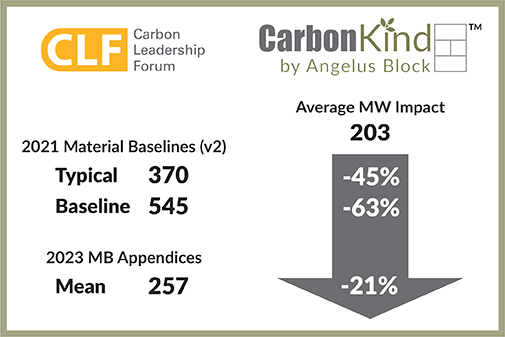
CarbonKind by Angelus Block achieves the largest CO2 reductions for CMU in the Southern California region.
CarbonKind CMU
Concrete masonry is recognized as an all-around performer – with seismic and fire resistance, durability, sound dampening, design flexibility, multiple functions, and cost benefits. Common concrete block contains a much lower percentage of cement than ready-mix concrete, giving it a good head start as a carbon-reducing material.
Angelus Block has taken this further with CarbonKind, a concrete masonry unit (CMU) with substantially lower CO2 impact. CarbonKind does not use higher-GHG ordinary Portland cement (OPC), but instead incorporates a blended cement, Portland-limestone cement, or PLC.
PLC is getting increased attention as an alternative to OPC. By reducing a portion of kiln-fired clinker, and replacing it – post kiln – with limestone, PLC reduces energy input and minimizes the CO2 released by its production. With use of PLC and other production and material efficiencies, CarbonKind eliminates a good portion of CO2 that would be typical of OPC products and provides low-carbon CMU produced with proven methods. It does not rely on nascent technologies that are not quite ready for a real-world marketplace.
To illustrate CarbonKind CO2 reductions, we can look to our collection of EPDs and Carbon Leadership Forum’s 2021 CLF Material Baselines (v2)1 which now includes CMU. The Baseline Report includes values of kg CO2e per m3. Medium Weight (MW) CMU are the predominant product type used in buildings. The average impact for all Angelus CarbonKind MW products is used in the illustration.
Reductions in CO2e of 43% from industry medians, and 61% from the CLF baseline are outstanding!
CarbonKind fully meets ASTM C90 and is available in all Angelus-produced CMU. Angelus Block is fully committed to advancing the sustainable contributions of concrete masonry and offers CarbonKind products without a cost premium.
LEED Benefits
With data now available from CLF, comparisons to baselines are possible. A new LEED v4.1 Pilot Credit, Procurement of Low Carbon Construction Materials (MRpc132), provides means to account for and define reductions in the embodied carbon of materials, and ultimately the building. Angelus CarbonKind cmu significantly contribute to the intent of this pilot credit.
CarbonKind Low Impact Systems
It gets even better. CarbonKind CMU in a concrete masonry wall fully grouted with high cement replacement masonry grout is a CO2 killer. Supplementary cementitious materials (SCM) in high percentages have been proven to create high-performing wall assemblies with outstanding reductions in CO2.2,3
Combined, CarbonKind and high-SCM masonry grout can reduce CO2 impacts of concrete masonry by more than half.
CarbonKind concrete masonry doesn’t stop there. Research has shown concrete-based structures, including concrete masonry walls, absorb and sequester atmospheric CO2 – during its service life, in demolished form, and as recycled aggregate. Studies have noted exposed concrete products can absorb up to 75% of its initial carbon impact, and possibly more as methods to determine absorbed carbon amounts improve.4
Considering all the above, CarbonKind and high-SCM grouted walls, along with their inherent CO2 absorption characteristics are well within reach of neutral carbon impact.
CarbonKind advances the sustainable and resilient properties of CMU and strengthens the efforts to stem carbon impacts of the built environment.
1 2021 Material Baselines - Carbon Leadership Forum
Carbon Leadership Forum content and logo are copyrighted and licensed under a Creative Commons Attribution 4.0 International license.
3 Concrete Masonry: An Optimized Low Carbon Wall
4 Preliminary Method to Determine CO2 Sequestration in Cementitious Units, By: Canan D’Avela, Jiangyin Bao, Fred W. Croxen III, Robert T. Downs, Steve Fickett, Hugh Rodrigues, David Rothstein, and Jason J. Thompson, TMS Journal, Vol. 34, No. 1, December 2016
The Masonry Society established a verifiable method to distinguish latent CO2 content in the material vs. absorbed CO2. This is an important step in understanding the extent to which concrete masonry can scrub carbon from the air.


